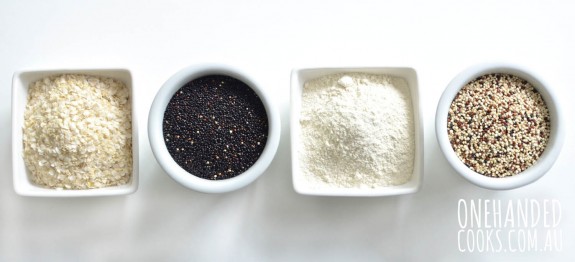Quinoa: Our Favourite Superfood
The term ‘superfood’ gets thrown around a lot but we think quinoa (pronounced keen-wa) deserves it. You may have noticed that we quite like quinoa, so do our bubs and so does the Food and Agricultural Organization of the United Nations (FAO). The FAO have declared 2013 the International Year of the Quinoa (IYQ). They want quinoa to be recognised and accepted as a natural food resource that is of high nutritive quality and value, is biodiverse and has a major role in the eradication of poverty.
Quinoa is well known for its nutritional qualities and is a very versatile grain that has so many uses in cooking. It’s lovely nutty taste and light fluffiness can be enjoyed at breakfast, lunch or dinner.
Note: For quinoa first-timers it is important to note that the flavour can be quite strong and for some it might be an acquired taste. You can try using half quinoa/half rice in recipes using quinoa grain or half quinoa flour/half wheat flour in recipes using quinoa flour if your children haven’t tried it before. It may help them becoming more accepting of it. When introduced early as a first food babies are often very accepting of the flavour and you can get very creative using quinoa in your cooking!
History
Quinoa is an ancient grain (well it’s actually a seed) with its origin dating back 3000-4000 years ago when it was cultivated by the Inca people in the Andes region of South America.
Nutritional Benefits
Where do we start? Quinoa is nutrient-rich and has so many nutritional qualities your child will benefit from. It’s is easy to digest and low in allergens meaning you can introduce it to your baby early. Babies often love the flavour too. You can think of it as a win-win food. They enjoy eating it and you feel great feeding it to them.
- Quality Protein: Quinoa is famous for being high in protein, containing all the essential amino acids. It is the only plant food that does contains all the essential amino acids making it perfect for vegetarians.
- Carbohydrate-rich and Low GI: Quinoa is carbohydrate-rich and has a low glycaemic index (GI) resulting in a sustained energy release giving children the energy to play and learn.
- High in Fibre: Quinoa is high in fibre, which is important for bowel health and helps to keep babies feeling full and satisfied after they have eaten.
- Low in Fat: Quinoa is relatively low in fat and predominantly the favourable unsaturated fats, including omega 3 and omega 6 fatty acids.
- High in Iron: Quinoa contains 3 times more iron than wheat and 4 times more iron than rice making it a great addition to babies’ food. Serving some vitamin C-rich foods along side quinoa will help boost the amount of iron absorbed.
- High in B-vitamins: Quinoa contains many B group vitamins such as riboflavin, niacin and thiamine that are important for energy production and release.
- Nutrient Rich: In addition to iron and many B-vitamins quinoa also contains notable amounts of vitamin A, vitamin E, vitamin C, calcium, potassium, magnesium, phosphorus, zinc, manganese and copper.
- Gluten Free: Quinoa is gluten free making it a nutritious option for anyone with coeliac disease.
- Antioxidants: Quinoa contains many health-promoting, disease-fighting antioxidants your babies will benefit from for years to come. Note: red, purple and black coloured quinoa are higher in antioxidants compared with white quinoa.
Nutrition Information*:
100g cooked quinoa (approx. ½ cup) provides: 120 calories (502 kJ), 4 g protein, 2 g total fat, 0 g saturated fat, 21 g carbohydrate, 3 g fibre, 7 mg sodium. * Self Nutrition Data (US). 2012. http://nutritiondata.self.com/
Buying Quinoa
Quinoa is becoming hugely popular these days so you can find quinoa in the health food section of most supermarkets. Alternatively, specialty health food stores and growers markets will most likely stock quinoa. You can also find it in many other supermarket items such as breads, breakfast cereals, pastas and crackers.
Types of Quinoa
- Quinoa Grain: This is its original form. It cooks in around 15 minutes and can be used in baby purees, mashes and finger foods, salads, soups, stuffing, fritters and as a substitute to cous cous and rice. It’s available as a white, red, black or purple grain. Most commercial quinoa is already washed however it is always good to give quinoa a good rinse prior to cooking to remove the saponins.
- Dry Roasted Quinoa Grain: This type of quinoa is lightly toasted to partially pre-cook the quinoa and reduce the cooking time to around 10 minutes. The process of dry roasting helps to eliminate the bitterness by removing the hull which contains saponins*
- Quinoa Flakes: The flakes are created by steam-rolling the whole grain. They cook almost “instantly” and can be used as an alternative to rolled oats, added to smoothies, pancakes or enjoyed as a breakfast cereal. Try them as a breadcrumb in meatballs or to coat fish or chicken fingers.
- Puffed Quinoa: Quinoa puffs can be enjoyed as a breakfast cereal, added to soups, salads or used in baking.
- Quinoa flour: In flour form quinoa can be used in baking. It is often combined with other gluten free flours to create a gluten free baking mix. We sometimes use half quinoa flour – half wheat flour in our baking recipes.
*Quinoa has a bitter residue of saponins to ward off insects and birds. Make sure you thoroughly rinse quinoa prior to cooking.
Want more?
Stay tuned for our post on ‘how to cook quinoa’ and a list of our favourite one handed cooks quinoa recipes.
Read more on the International Year of the Quinoa here.





























posted by Leanne on March 6, 2013
Completely agree Jess. Quinoa has been my go-to carb for years now. How amazing that 2013 is year of quinoa!